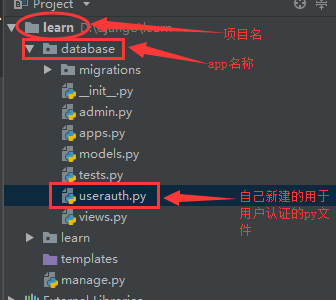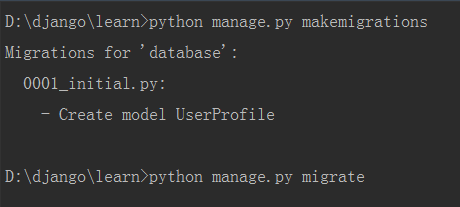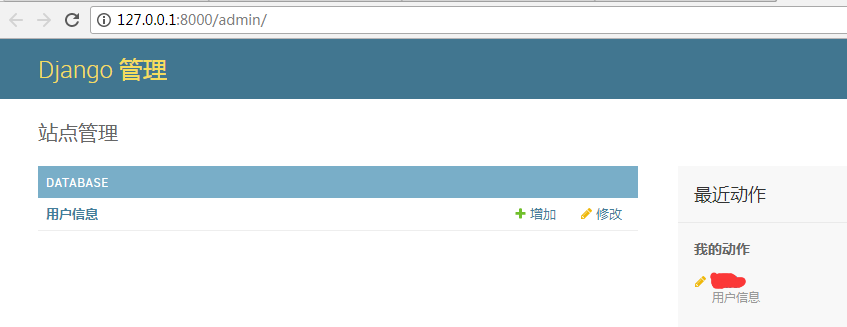自定义用户认证(继承django的)
1、在app下创建一个自己用户认证文件,文件名随意,记得为.py文件

2、编辑该userauth.py文件
#!/usr/bin/env python
#coding:utf-8
from django.db import models
from django.contrib.auth.models import (
BaseUserManager, AbstractBaseUser
)
import django class UserManager(BaseUserManager):
def create_user(self, email, name, password=None):
"""
Creates and saves a User with the given email, date of
birth and password.
"""
if not email:
raise ValueError('Users must have an email address') user = self.model(
email=self.normalize_email(email),
name=name,
#token=token,
#department=department,
#tel=tel,
#memo=memo, ) user.set_password(password)
user.save(using=self._db)
return user def create_superuser(self, email, name ,password):
"""
Creates and saves a superuser with the given email, date of
birth and password.
"""
user = self.create_user(email,
password=password,
name=name,
#token=token,
#department=department,
#tel=tel,
#memo=memo,
)
user.is_admin = True
user.save(using=self._db)
return user class UserProfile(AbstractBaseUser):
email = models.EmailField(
verbose_name='email address',
max_length=255,
unique=True,
) is_active = models.BooleanField(default=True)
is_admin = models.BooleanField(default=False) name = models.CharField(u'名字', max_length=32)
token = models.CharField(u'token', max_length=128,default=None,blank=True,null=True)
department = models.CharField(u'部门', max_length=32,default=None,blank=True,null=True) mobile = models.CharField(u'手机', max_length=32,default=None,blank=True,null=True) memo = models.TextField(u'备注', blank=True,null=True,default=None)
date_joined = models.DateTimeField(blank=True, auto_now_add=True)
valid_begin_time = models.DateTimeField(default=django.utils.timezone.now)
valid_end_time = models.DateTimeField(blank=True,null=True) USERNAME_FIELD = 'email' #定义email为用户名
#REQUIRED_FIELDS = ['name','token','department','tel','mobile','memo']
REQUIRED_FIELDS = ['name'] def get_full_name(self):
# The user is identified by their email address
return self.email def get_short_name(self):
# The user is identified by their email address
return self.email def __str__(self): # __unicode__ on Python 2
return self.email def has_perm(self, perm, obj=None):
"Does the user have a specific permission?"
# Simplest possible answer: Yes, always
return True
def has_perms(self, perm, obj=None):
"Does the user have a specific permission?"
# Simplest possible answer: Yes, always
return True
def has_module_perms(self, app_label):
"Does the user have permissions to view the app `app_label`?"
# Simplest possible answer: Yes, always
return True @property
def is_staff(self):
"Is the user a member of staff?"
# Simplest possible answer: All admins are staff
return self.is_admin class Meta:
verbose_name = u'用户信息'
verbose_name_plural = u"用户信息"
def __unicode__(self):
return self.name objects = UserManager()
3、在models中导入该文件中的UserProfile类

4、admin中注册
编辑admin.py文件
#_*_coding:utf8_*_
from django.contrib import admin # Register your models here. from django import forms
from django.contrib import admin
from django.contrib.auth.models import Group
from django.contrib.auth.admin import UserAdmin
from django.contrib.auth.forms import ReadOnlyPasswordHashField
import models from userauth import UserProfile
from django.contrib.auth import forms as auth_form class UserCreationForm(forms.ModelForm):
"""A form for creating new users. Includes all the required
fields, plus a repeated password."""
password1 = forms.CharField(label='Password', widget=forms.PasswordInput)
password2 = forms.CharField(label='Password confirmation', widget=forms.PasswordInput) class Meta:
model = UserProfile
fields = ('email','token') def clean_password2(self):
# Check that the two password entries match
password1 = self.cleaned_data.get("password1")
password2 = self.cleaned_data.get("password2")
if password1 and password2 and password1 != password2:
raise forms.ValidationError("Passwords don't match")
return password2 def save(self, commit=True):
# Save the provided password in hashed format
user = super(UserCreationForm, self).save(commit=False)
user.set_password(self.cleaned_data["password1"])
if commit:
user.save()
return user class UserChangeForm(forms.ModelForm):
"""A form for updating users. Includes all the fields on
the user, but replaces the password field with admin's
password hash display field.
"""
password = ReadOnlyPasswordHashField(label="Password",
help_text=("Raw passwords are not stored, so there is no way to see "
"this user's password, but you can change the password "
"using <a href=\"password/\">this form</a>.")) class Meta:
model = UserProfile
fields = ('email', 'password','is_active', 'is_admin') def clean_password(self):
# Regardless of what the user provides, return the initial value.
# This is done here, rather than on the field, because the
# field does not have access to the initial value
return self.initial["password"]
class UserProfileAdmin(UserAdmin):
# The forms to add and change user instances
form = UserChangeForm
add_form = UserCreationForm # The fields to be used in displaying the User model.
# These override the definitions on the base UserAdmin
# that reference specific fields on auth.User.
list_display = ('id','email','is_admin','is_active')
list_filter = ('is_admin',)
fieldsets = (
(None, {'fields': ('email', 'password')}),
('Personal info', {'fields': ('department','name','mobile','memo')}),
('API TOKEN info', {'fields': ('token',)}),
('Permissions', {'fields': ('is_active','is_admin')}),
('账户有效期', {'fields': ('valid_begin_time','valid_end_time')}),
)
# add_fieldsets is not a standard ModelAdmin attribute. UserAdmin
# overrides get_fieldsets to use this attribute when creating a user.
add_fieldsets = (
(None, {
'classes': ('wide',),
'fields': ('email', 'password1', 'password2','is_active','is_admin')}
),
)
search_fields = ('email',)
ordering = ('email',)
filter_horizontal = () # Now register the new UserAdmin...
admin.site.register(models.UserProfile,UserProfileAdmin)
admin.site.unregister(Group)
#这里需注意,第51行
"using <a href=\"password/\">this form</a>.")) #这是django1.8的写法,如果>1.8的话需要修改成
"using <a href=\"../password/\">this form</a>."))
否则在admin后台点击修改密码的话会提示404找不到页面
5、在settings告诉django使用我们自己定义的用户认证系统
修改settings,结尾添加
AUTH_USER_MODEL = 'database.UserProfile'
#database为app名称
#UserProfile为我们刚才在userauth.py中创建的类名称
6、同步数据库

可以看到创建了UserProfile表,这样就可以直接使用django的用户认证功能
7、创建超级用户

可以看到提示已经跟django默认的不一样了,以email地址作为用户名
8、此时访问django admin

自定义用户认证(继承django的)的更多相关文章
- 使用django实现自定义用户认证
参考资料:https://docs.djangoproject.com/en/1.10/topics/auth/customizing/ 直接拉到最后看栗子啦 django自定义用户认证(使用自 ...
- Django自定义用户认证
自定义一个用户认证 详细参考官方文档: https://docs.djangoproject.com/en/1.9/topics/auth/customizing/#django.contrib.au ...
- Django自定义用户认证系统之自定义用户模型
参考文档:http://python.usyiyi.cn/django/topics/auth/customizing.html Django 自带的认证系统足够应付大多数情况,但你或许不打算使用现成 ...
- CMDB资产管理系统开发【day25】:Django 自定义用户认证
官方文档:https://docs.djangoproject.com/en/1.10/topics/auth/customizing/#substituting-a-custom-user-mode ...
- Django--分页器(paginator)、Django的用户认证、Django的FORM表单
分页器(paginator) >>> from django.core.paginator import Paginator >>> objects = ['joh ...
- 43)django-用户认证,授权,自定义用户认证
##用户认证 django自带用户认证系统,包括认证和授权.用户认证系统由用户,权限,用户组,密码,cookie和session给组成. ###用户认证系统设置 #settings.py INSTAL ...
- YII2中自定义用户认证模型,完成登陆和注册
有些时候我们需要自已定义用户类,操作自已建的用户表,来完成登陆和注册功能. 用户表结构如下,当然可以根据自已的需要添加或删除: CREATE TABLE `tb_user` ( `id` int(11 ...
- spring Security的自定义用户认证
首先我需要在xml文件中声明.我要进行自定义用户的认证类,也就是我要自己从数据库中进行查询 <http pattern="/*.html" security="no ...
- Django自定义用户认证系统Customizing authentication
扩展已有的用户模型Extending the existing User model 有两种方法来扩展默认的User Model而不用重写自己的模型.如果你不需要改变存储在数据库中的字段,而只是需要改 ...
随机推荐
- Uva - 1594 - Ducci Sequence
水题,算出每次的结果,比较是否全0,循环1000次还不是全0则LOOP AC代码: #include <iostream> #include <cstdio> #include ...
- 并发编程(三): 使用C++11实现无锁stack(lock-free stack)
前几篇文章,我们讨论了如何使用mutex保护数据及使用使用condition variable在多线程中进行同步.然而,使用mutex将会导致一下问题: 等待互斥锁会消耗宝贵的时间 - 有时候是很多时 ...
- linux下使用异步通知
阻塞式I/O是一直等待直到设备可以访问,非阻塞式I/O是定期轮询设备是否可以访问. 异步通知则是当设备可以访问时才主动通知应用程序,有点像设备的硬中断. 并不是所有的设备都支持异步通知,应用程序通常假 ...
- Linux Debugging(一): 使用反汇编理解C++程序函数调用栈
拿到CoreDump后,如果看到的地址都是????,那么基本上可以确定,程序的栈被破坏掉了.GDB也是使用函数的调用栈去还原"事故现场"的.因此理解函数调用栈,是使用GDB进行现场 ...
- 【Android 应用开发】Android 网络编程 API笔记 - java.net 包 权限 地址 套接字 相关类 简介
Android 网络编程相关的包 : 9 包, 20 接口, 103 类, 6 枚举, 14异常; -- Java包 : java.net 包 (6接口, 34类, 2枚举, 12异常); -- An ...
- AngularJS进阶(三十一)AngularJS项目开发技巧之获取模态对话框中的组件ID
AngularJS项目开发技巧之获取模态对话框中的组件ID 需求 出于项目开发需求,需要实现的业务逻辑是:药店端点击查看"已发货""已收货"订单详情时,模块弹出 ...
- 反对网抄,没有规则可以创建目标"install" 靠谱解答
在ubuntu下遇到这个问题,原因其实很简单,你不能用WINDWOS下的方法用图形方式打开,然后点了一下按扭"解压缩",生成了一个文件夹. 的确,这个文件夹看起来和正常的没有什么区 ...
- 在Android中afinal框架下实现sqlite数据库版本升级的办法
上一篇文章采用的是SQLiteOpenHelper中的onUpgrade方法实现数据库的升级. 首先获取Context: private Context mContext=this; 然后实现Fina ...
- AngularJS进阶(一)深入理解ANGULARUI路由_UI-ROUTER
深入理解ANGULARUI路由_UI-ROUTER 最近在用 ionic写个webapp 看到几个demo中路由有好几种,搞的有点晕,查下资料研究下,做个笔记,其中大部分为摘抄别人的,做个说明免得被人 ...
- windows下追踪路由
追踪路由 tracert 目标ip/域名 测试两个ip是否畅通 ping 目标ip 在windows查看ip情况 ipconfig linux/unix下查看ip情况的使用 ifconfig
